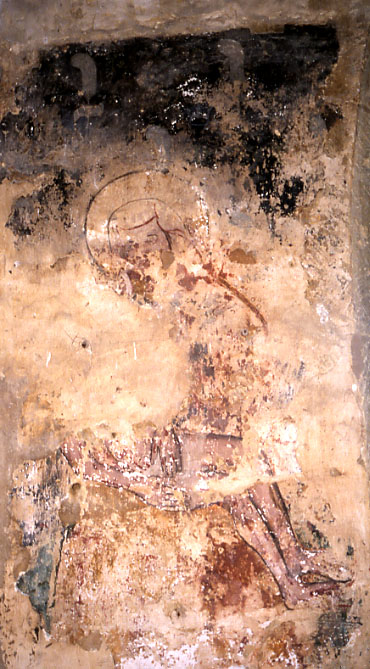Hornton, Oxfordshire (†Oxford) C.15
Pietà (Our Lady of Pity)

Such evidence as there is points to the widespread popularity of all forms of this image – generally called in England ‘Our Lady of Pity’ – but after the Reformation it was attacked with as much ardour as it had once been reverenced, and there are very few wall paintings of the subject left.¹ One, in an even more battered state than the Hornton example, is at Slapton in Northamptonshire, where many other paintings remain.²
The Virgin is depicted as sorrowing mother, holding the body of her dead son across her lap. Since the scene is not part of the Biblical narrative of the Passion, it was never part of the Passion Cycle, and at Hornton it is painted on the north side chancel arch wall, and thus faces the people in the nave directly. It seems to be complete in itself as an object of devotion and does not, as at Broughton, form part of a ‘Morality’ painting. Quite possibly there was once an subsidiary screen-altar below it, at which devotions might be made.
The dark area of pigment above the Virgin’s head almost certainly belonged to an earlier painting. It shows three heraldic ostrich feathers, with what seem to be escrolles, or ornamental labels bearing inscriptions below. These are arranged in triangular formation, with the central and lowest one half-hidden under the Virgin’s halo, and between them on the dark (perhaps once heraldically sable), background are some very faint isolated letters in Lombardic capitals. The design might or might not have some connection with the Black Prince (1330-76), whose ‘arms of peace’ bore the three feathers on a sable ground with his famous motto ‘Ich Dien’ on the escrolles. But the Black Prince’s feathers curved to the right, not the left, as here – again that might mean something or nothing – and my understanding of the complexities of heraldry is at best elementary.
In the corresponding position on the south side of the chancel arch is a painting of St George (on foot) spearing the Dragon, as well as a damaged but interesting Doom (forthcoming).
Website for St John the Baptist, Hornton
¹ There is good material on Our Lady of Pity and attitudes to it in Eamon Duffy’s The Stripping of the Altars, Yale, 1992, p. 38 & passim.
² e.g.St Christopher, St Francis receiving the Stigmata, etc.